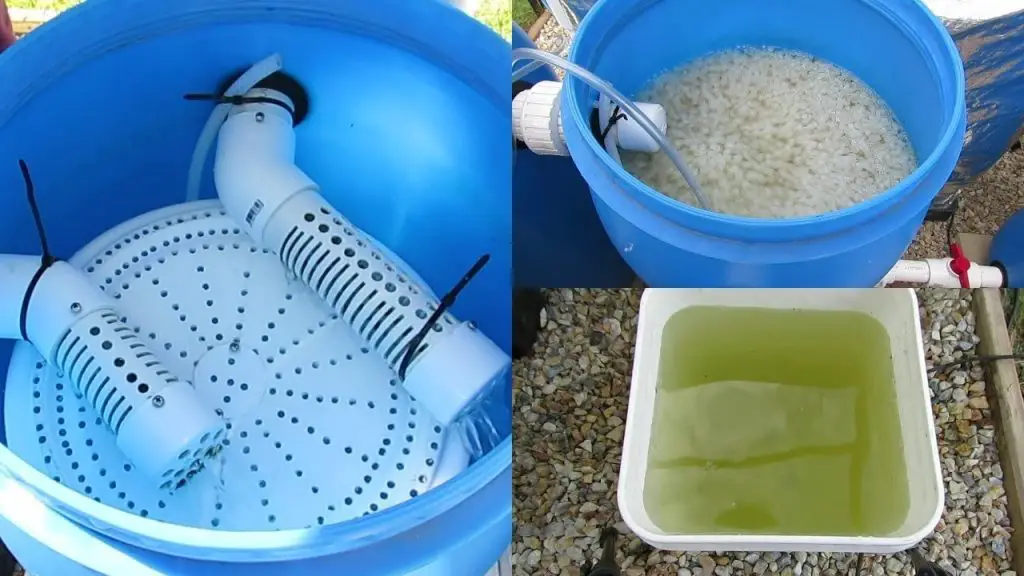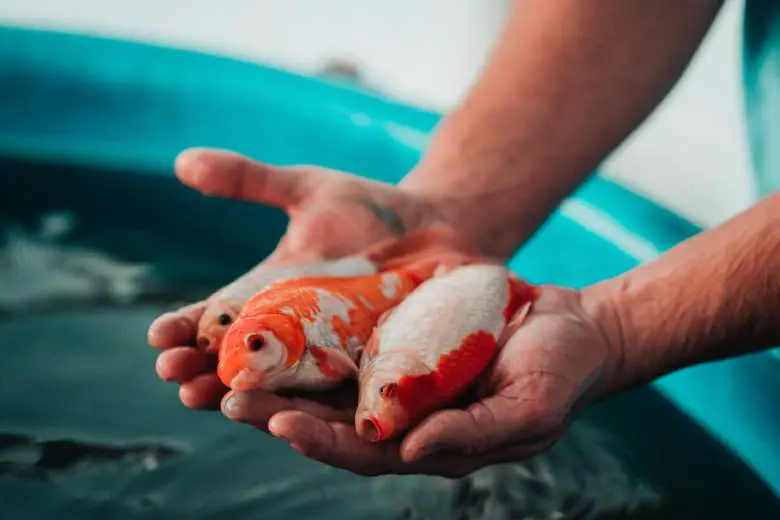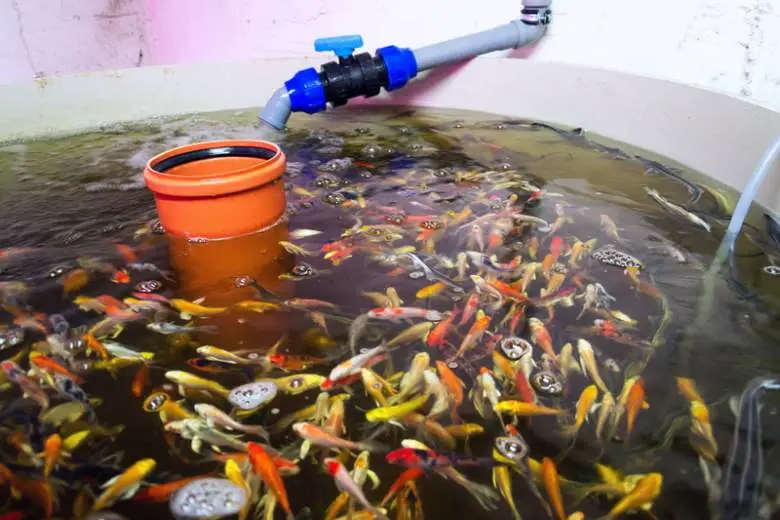If you’re a beginner in aquaponics, the first thing you need to know is that a symbiotic environment between plants and aquatic animals is only possible because of a biofilter.
The biofilter is a component of an aquaponics system that allows beneficial bacteria to thrive.
The main purpose of the biofilter might be to convert toxic ammonia into nutrients, but there are many things to consider when it comes to buying one.
Media size, media type, design, and age of fish are all factors that can affect the proper functioning of a biofilter.
Don’t worry, though! In the following article, we will go over all there is to know about biofilters, including benefits, types, and why it’s a must-have for a harmonious co-existence of fish and plants.
Why Is A Biofilter Needed In Aquaponics?
Imitating nature is the underlying tenet of aquaponics, creating an environment of co-dependency between fish life and plant life. To flourish symbiotically, each relies on the other for nutrients, food, filtration, the conversion of waste materials into nitrates, and the ability to recirculate cleaned water back into the system.
This self-sustaining environment combines the benefits of aquaculture with the system of hydroponics, but it wouldn’t function quite so harmoniously and seamlessly without bacteria. To understand the need for bacteria it is necessary to know how aquaponics work, and that will determine whether a biofilter will be required or not.
The overriding principle with aquaponics is that there is no reliance on fertilizers to aid in plant growth. That chore is undertaken by nutrients. But where do they come from and how are they replenished?
A closed-circuit system like aquaponics utilizes the water from the fish tank to transport nutrients and water in a closed-circuit cycle. known as the nitrogen flow cycle, to the roots of the plants and back again.
The process is initiated by the waste from fish farming and as this waste material begins to decay it starts to be broken down into ammonia. If left unchecked, this ammonia will turn toxic to the underwater dwellers and eventually lead to their demise. Adding to this build-up of ammonia will be the decaying organic matter of leftover food and dead plant segments.
In aquaponics, a conversion process starts to occur due to the interference of beneficial nitrifying bacteria, where the mounting toxic ammonia is converted into nitrite compounds. At this phase, the danger to the fish has been eliminated but the nitrite is still not usable for the nourishment purposes of the plants. What they need are nitrates.
A friendly bacterium called Nitrobacter is the leading protein in the oxidation process that will ultimately convert nitrites into nitrates, so the nutrients can now be absorbed as plant food. Without this beneficial bacterium, the aquaponics farm would fail.
So, if this system functions so seamlessly without any intervention required, why would a biofilter be needed?
The aquaponics closed-cycle system works when there are sufficient beneficial bacteria to complete the conversion cycle. If there is a shortfall due to a lack of surface area for the bacteria to grow, then more bacteria have to be introduced somewhere along the conversion line to make the world go around.
Also see: Do Fish Need Light in Aquaponics
How Do Aquaponic Biofilters Work?

Biofilters are essentially a large surface area attached to the aquaponic farm where additional bacteria can set up a colony and grow, increasing the efficiency of the nitrification process if it is underperforming.
Bacterial conversion, from ammonia to nitrites to nitrates, occurs in all aquaponics systems. The need for a biofilter can become necessary if there is an increase in the fish stock in the tank. This can be the result of a spike with breeding, and if so more fish generally equates to more poop, and proportionally more waste means more ammonia.
If this accumulation continues unchecked, the aquaponics farm can enter the forbidden zone very quickly. Therefore, it is imperative to recognize when the biosphere is in jeopardy and act accordingly to expand the playing field. Fortunately, a biofilter will correct this imbalance automatically if connected to the circuit.
The setting-up process of interconnecting the two and expanding the surface area is not that complicated. It consists of another tank with one or more air pumps that are used to push water from the new side to the old, so they now operate on the same circuit.
Sand or gravel is most commonly used as the growing medium as it allows the colonization of the bacteria to progress easier. Nitrifying bacteria start to proliferate on the expanded surface area and, because bacteria require oxygen to grow and thrive, the biofilter should be set for additional aeration for maximum growth.
Plants will now be able to perform their duties after receiving the nutrients, by cleaning the water which is then returned back to the fish tank to start the cycle all over again. This expansion increases the efficiency of the nitrification process considerably.
All of this process is important to the chemical stability of an aquaponic biosphere, the well-being of your fish, and the successful growing of your crops. And the good thing is that nothing goes to waste, recycled as it is again and again.
Do You Need a Biofilter in Aquaponics Systems?
An aquaponics farm is in essence its own filtration system. And an efficient one at that. But with two living organisms to co-exist together a balance has to be reached or one will thrive and the other will decline. There are several factors that need to be considered.
The pH balance is front and center among them. A reading of 7.0 to 7.5 is considered neutral and is ideal for both organisms. If that level drops below 6.0 the nitrification process will slowly grind to a halt and become toxic to the fish and the plants will not receive enough nutrients.
Regular monitoring will detect the pH imbalance which can then be corrected before it gets into this danger zone.
Check out the Best pH Meters in 2022!
This recalibration occurs naturally in a system that has a growing medium of gravel, clay, or lava stones as long as the surface area is large enough to encourage bacteria growth. In this case, a biofilter will not be necessary, the grow beds themselves being the ultimate biofilter.
Problems occur, however, when this natural filtration system is overwhelmed by fish waste. This imbalance arises if more fish are added at a later date, or more fish are birthed in the tank, or even if too much fish food is being entered into the habitat, not eaten, sinks to the bottom and starts to decay. Either one of these will spike the production of ammonia.
Types of Biofilters
When installing a biofilter the location has to be situated after the mechanical filter as it is not designed to handle large fish waste deposits which can become trapped in the pipes. If this happens, the waste will continue to accumulate, creating an anaerobic zone that will encourage excessive bacteria growth away from the expanded surface area which will not be utilized, and that will reduce the efficiency of the biofilter.
The mechanical filter acts as a screening filter to control this build-up of solids so the level of ammonia will not become too much for the biofilter to cope with.
There are various models of biofilters but these three are the most frequently used:
A Moving Bed Filter, also known as a Moving Bed Biological Reactor (MBBR), is a biofiltration model that is constantly in motion and at its core revolves around K1 media and constant aeration.
K1 media are made of small plastic discs and are ideal for trapping particles suspended in the water, and their large surface area encourages the growth of bacteria. With their virtual neutral buoyancy ability, they are subjected to a steady stream of air pressure that aerates the water and pushes them around.
This type of biofilter is essentially a constant flow system that uses an air pump to keep well-oxygenated water churning over, essentially creating a biological reactor. This system keeps the K1 media floating and in motion, assisting in the collection of good bacteria, and is especially effective in a raft aquaponics system.
Due to the collision of the media, each disk performs a continual self-cleaning process and this helps by keeping the nitrifying bacteria rejuvenated for optimum ammonia and nitrite nitrification.
A Static Filter biofilter has the advantage of the ease of use and ease of setup. It is essentially a flat tray in a separate container next to the plants, filled with a media mat to provide a sufficiently large enough zone to grow the necessary bacteria needed for the biofilter to work to its fullest potential.
The deeper the biofilter media incorporated, the more beneficial bacteria will be nurtured. Here, the principal theory is the water flows through the tray at one end into the media, the conversion from ammonia to nitrates occurs, and the cleaned water flows out through the opposite side back into the closed system.
With a Drip Filter, the water drips into the system from the top, passes through the bio medium at a slow rate, performing the vital conversion process from ammonia to nitrates, and flows out the bottom on its way back to the fish, completing the cycle.
The Need For The Biofilter
A biofilter doesn’t have to be a part of the aquaponics system from the initial setup. It can be integrated at a later stage as and when needed. The good news is that its inclusion isn’t a costly addition, and some would say it’s better to have it in place on standby if needed urgently. It is always better to have a quick fallback solution on hand if a nasty build-up of ammonia surges unexpectedly.
The fact that a biofilter requires very little maintenance is a reason all in itself to have one. There is no downside to having one even in this self-sufficient aquaponics biosphere. It can be implemented at any time to regulate ammonia, supplying enough oxygen for additional bacteria growth when required.
Sometimes adjustments in the aquaponics system can create an imbalance between ammonia build-up and lack of nitrates. This can occur due to plants being replaced, reduced and the opposite reactions can occur if the fish population is increased.
What has to be considered, and is often overlooked by beginners and some experienced aquaponics farmers, is the age of the fish being added into this bio-sphere. To maintain the equilibrium a specific stocking method has to be adopted.
This includes having a staggered age range of the fish throughout the same tank and employing a harvesting regime every three months. A recommended approach is to harvest the more mature fish who are now weighing about 500g and restock them with new fingerlings or juvenile fish weighing about 50g each.
This staggered approach is to avoid swapping out of all the fish at the same time and to alleviate the sudden impact on the system. If a full fish exchange took place at the same time, out with the old and in with the young, then that would result in too much of a drastic adjustment requirement in regards to the filtration process.
Another reason for implementing this rotation is that larger fish tend to eat more than their juvenile co-inhabitants. And when larger fish if eat more they are going to excrete more waste. If this re-stocking process is not utilized, ammonia can reach unfavorable levels, rising completely unnoticed until something starts to die off.
Monitoring and reacting to this fluctuation can take years of experience as well as constantly keeping a close eye on the ph level. With a biofilter connected, these fluctuations are automatically adjusted as the water and the waste are washed through it, maintaining the delicate balance of this bio-diverse system.
The bottom line, the final word, on if a biofilter is necessary for a self-sustaining system like aquaponics, is yes.
Without one, time-consuming re-calibration tasks would need to be incorporated into a more frequent maintenance routine.
With one, your aquaponics farm will be a problem-free dream to run, and your plants, your fish, and your precious time will be the happy beneficiaries.





